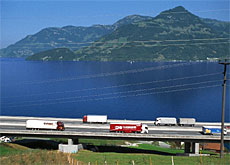Hydrogen car powers to record finish

A special hydrogen-powered car invented by Swiss scientists has set a new world record.
The PAC 11 car came in first at the recent Shell Eco-Marathon in Ladoux, France, completing a 25-kilometre circuit using only one gram of hydrogen.
This converts to about 5,385 kilometres per litre of petrol, a new world record in economical fuel consumption, and means that PAC-Car would only use eight litres to drive around the globe.
At the marathon, 25 cars, travelling at a minimum average speed of 30kmph, competed for the best fuel efficiency title.
The groundbreaking model was developed by a team of 20 mechanical engineering students at the Federal Institute of Technology in Zurich.
Team leader Lino Guzzella outlined the winning formula: “Lightweight design, aerodynamics, controls, power electronics, chemistry – the real hard engineering stuff.”
He said the prestigious prize was a great boost for the institute, and would help his department to attract talented students in years to come.
“It’s a beacon signal that I am sending out, so that people know something very good is going on here,” he told swissinfo.
Hot Rod
The PAC car is less than three metres long and resembles a competition bob sleigh with wheels.
The diminutive driver at the Shell competition, Fanny Frei, weighs 45 kilograms.
She had to lie horizontally inside the cockpit, with her head slightly raised so that she could see the control panel, which helped her to maintain an optimal speed to minimise hydrogen consumption.
A hand-held unit encompasses the accelerator and simple bicycle style breaks.
“The race was fun, but it was very hot,” Frei said. “The outside temperature was 30 degrees Celsius, so it must have been 50°C inside the cockpit.”
How it works
PAC stands for “pile à combustible” – in other words, fuel cell. This takes in hydrogen and air, and uses an AC/DC converter to provide the energy needed to drive the two motors.
Two one-litre hydrogen cartridges are tucked inside the back of the vehicle, each containing 11 standard litres of hydrogen, pressurised at 11 bars.
Florian Kolb, who worked on the optimisation of the fuel cell, says the amount of hydrogen carried on board is flexible.
“You could use a tank of up to 200 bars and store 200 litres in such a bottle, so the range could be extended a lot.”
But hydrogen is highly explosive, so safety tests had to be carried out before the system could be put to use. “It’s quite explosive but if the car were to crash, the gas would just dissipate. It’s one-twentieth the weight of air, so it’s gone before it explodes,” said Kolb.
Drag Factor
One of the winning features of PAC-Car 11 is its aerodynamics.
“The aerodynamic drag of Pac Car 1 was about 50 per cent of the whole drag,” said Nicolas Weidmann, who was in charge of redesigning an earlier model, PAC Car 1.
“We were able to improve the resistance on the new car, and it is now only a fourth of the amount of drag of the earlier model,” he added.
He achieved this by tilting the wheels by eight degrees, as a compromise between rolling resistance and aerodynamic drag.
Wind tunnel tests were carried out on the vehicle at the Federal Institute of Technology and Ruag Aerodynamics in Emmen, where there is a rolling floor.
Promoting clean cars
The project’s main sponsor was the Federal Energy Office, which is hoping to promote energy efficient systems and renewable energy.
“The PAC car is an ideal training platform for the students, and the project helps to make the public more aware of the importance of greater fuel efficiency,” said Martin Pulver.
But the expert on rational energy use estimates that Switzerland is decades away from developing the PAC-Car on a commercial scale, because hydrogen is not produced industrially and cannot be easily stored.
The government and parliament are at odds over the introduction of “climate” taxes on petrol and diesel imports from next January.
It’s part of Swiss efforts to honour the Kyoto protocol, by reducing carbon dioxide emissions to ten per cent below 1990 levels by 2010.
These levies are expected to generate almost SFr100 million ($78 million), about a third of which will be directed to traffic improvement projects.
“We can use this money to promote research into and boost markets for energy-efficient cars,” Pulver said.
swissinfo, Julie Hunt in Zurich
The PAC 11 car shell is made of carbon fibre materials, and weighs just 10kg.
The vehicle is nearly three metres long, half a metre wide and 61 centimetres high.
It can reach a maximum speed of 35kmph.
Each canister contains two grams of hydrogen, pressurized at 11 bars, which is equal to two millilitres of petrol.

In compliance with the JTI standards
More: SWI swissinfo.ch certified by the Journalism Trust Initiative











You can find an overview of ongoing debates with our journalists here . Please join us!
If you want to start a conversation about a topic raised in this article or want to report factual errors, email us at english@swissinfo.ch.